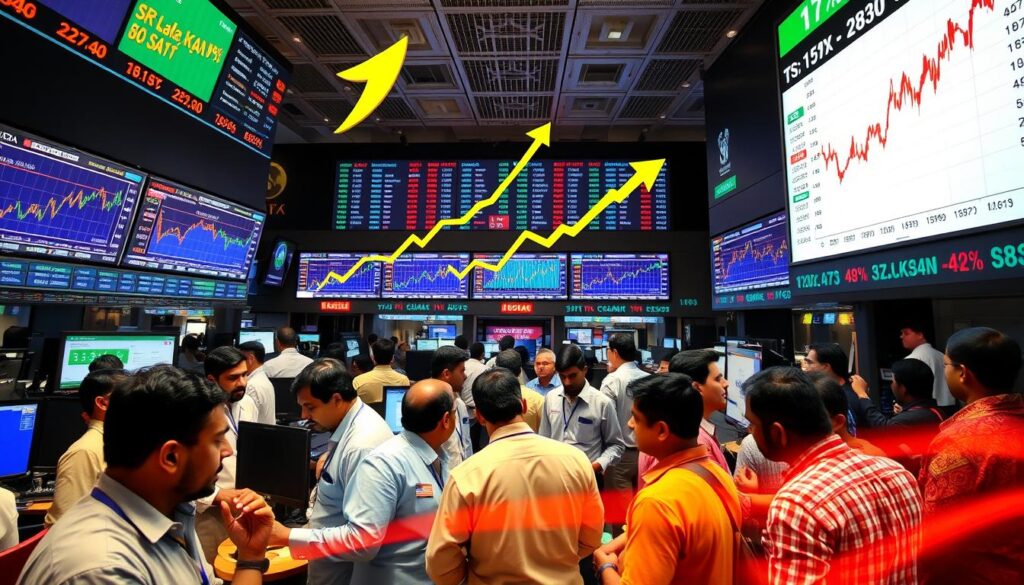ASPI Surges 15% as Stock Market Recovers in 2024
The Sri Lankan stock market showed strong recovery in 2024. The All Share Price Index (ASPI) went up a lot in the first half of the year. This was a big moment for the country’s economic bounce back. It showed investors were feeling good about putting their money in Sri Lanka. The rise in the ASPI index was a sign of growing confidence. It also showed the country’s overall economic improvement.
The economy of Sri Lanka is looking up, according to fiscal data. Government revenue jumped from Rs. 1,448 billion in 2022 to Rs. 2,110 billion in 2023. Meanwhile, tax revenue went from Rs. 1,283 billion to Rs. 1,934 billion. At the same time, government spending increased a lot. This was to help the economy grow more.
The country sold less abroad, with exports dropping. However, the tourism sector saw a lot more visitors. This showed the world is trusting Sri Lanka more. There was also a big increase in money sent home by workers abroad. This helped improve the country’s financial health overall.
The recovery of the stock market was helped by better monetary conditions. The interest rates banks charge each other fell significantly. And, the returns on short-term government loans also went down. This made it cheaper for people and companies to borrow money. This likely helped the stock market do well, attracting both local and global investors.

The 15% increase in the ASPI shows Sri Lanka’s economic progress. These results are good news. But, we need to watch the world’s political and economic changes too. They could affect the market. Still, this positive change gives hope for a strong market and ongoing investments ahead.
Analyzing the Reasons Behind ASPI’s 15% Climb
The All Share Price Index (ASPI) of the Sri Lankan stock market rose by 15% in 2024. This jump shows the impact of different factors. The foreign investment trends, updated economic policies, and sectoral performance together led to this market upturn.
The Impact of Foreign Investment Trends on ASPI
Foreign investment is key to the Sri Lankan stock market. There’s an ongoing change between money coming in and out. Even with a net foreign outflow in 2024, foreign investors bought LKR 100 million worth. This indicates global trust in some market sectors.
How Economic Policies Influenced the Stock Market Recovery
New economic policies have helped the market find stable ground. The 2024 Fiscal Management Report outlines a focus on spending smart and increasing revenue. These actions helped the Sri Lankan stock market find balance, aiding the ASPI’s rise.
Sectoral Performances Driving ASPI’s Surge
Important sectors like financial services helped push the ASPI up. Sectors such as diversified financials, food, beverage, & tobacco, have seen big growth. They played a major part in the ASPI’s 15% increase in 2024.
| Sector | Contribution to Turnover | Percentage of Total Market Turnover |
|---|---|---|
| Banking and Financial Services | LKR 662 million | 30% |
| Diversified Financials | LKR 403 million | 18% |
| Food, Beverage & Tobacco | LKR 400 million | 18% |
| Capital Goods | LKR 210 million | 9% |
| Consumer Services | LKR 173 million | 8% |
With market capitalization on the rise, it’s evident that specific investments and policies worked together to lift the ASPI. These efforts show the detailed work needed in Sri Lankan stock market analysis. It illustrates how government, sectoral, and global factors combine to boost the market.

Stock Market Recovers, ASPI Gains 15% in First Half of 2024
The financial news from Sri Lanka’s stock market is positive. The All-Share Price Index (ASPI) went up by 15% in the first half of 2024. This shows the market and economy are strong. Investors are showing confidence in different sectors, not just one. Banks and John Keells Holdings made big contributions. The S&P 20 index also went up by about 19%, showing great investment chances in the country.
Local money flowing into the market has helped it recover. This is because investment in bonds is giving lower returns. Also, investors are taking less risk. This change matches well with the good news from the International Monetary Fund (IMF). Past financial troubles made the Sri Lankan Rupee drop. But now, the market could go up by 40-60% in the next 18 months. This is if it keeps following the IMF’s advice and gets ongoing investor support.
As people become more hopeful about the market, how Sri Lanka deals with its foreign debt is crucial. If banks do well, we might see changes in the stock market. The market has grown, showing a 9.77% gain recently. Measures of market health look good too. Local players, wealthy individuals, and regular folks have good expectations for mid-2025. They think the market will keep getting better. This is linked to peaceful changes in politics, moving towards the Janatha Vimukthi Peramuna (JVP). The story of Sri Lanka’s economic recovery ties into this political shift. This shows the stock market’s rise is also a sign of the country’s overall strength.



